 I’ll start with a general discussion of uranium its uses, production, resources and the main uranium ore minerals. Then I want to focus the bulk of the course on the types of Uranium Ore deposits, discussing as I go along how those deposit types are formed and how we go about exploring for them. Then I’ll course briefly about how Uranium deposits are mined and how the ore is treated to produce a final saleable product. As usual I’ll end up with a short list of critical take away points.
I’ll start with a general discussion of uranium its uses, production, resources and the main uranium ore minerals. Then I want to focus the bulk of the course on the types of Uranium Ore deposits, discussing as I go along how those deposit types are formed and how we go about exploring for them. Then I’ll course briefly about how Uranium deposits are mined and how the ore is treated to produce a final saleable product. As usual I’ll end up with a short list of critical take away points.

So let’s starts off with some background to Uranium and the Uranium mining industry. What makes Uranium a particularly economic importance is its radioactivity. Uranium decays through a series of reactions to form a number of new elements:
- Thorium
- Radium
- Radon
- Polonium
- Lead
At each of these steps it spins off alpha particles from the nucleus and produces energy. Uranium is not a rare element, it’s found in most rocks although it is more common in felsic rocks like granite than in mafic rocks like gabor.
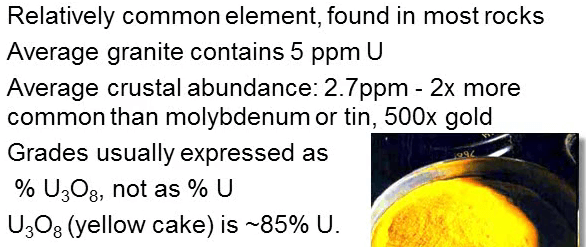
Granite in general contains about five parts of a million of uranium. This grade will be more than enough to form an economic deposit, if we dealing with gold but uranium need a lot of natural enrichment to reach economic grades. Uranium’s average crustal abundance is 2.7 parts of a million which makes it twice as common as molybdenum or tin 40 times more abundant than silver and 500 times more abundant than gold but the lowest grade primary uranium deposits being mined today have about 100 times of this crustal abundance.
The highest grade deposits have about 5 million times this concentration. Uranium grades are usually expressed in terms of percent U3O8. The usual saleable end product is U3O8 or yellow cake as it’s commonly called. This contains approximately 85% of uranium by weight but uranium is an emotive product with its mental associations with past nuclear disasters, nuclear weapons and the fear of the invisible. The ghost of Three Mile Island, Chernobyl and Fukoshima loom large in public’s mind. Much of the future demand for uranium depends on this emotive factor. The war of words waged between those strongly in favor of nuclear power versus those passionately against it, however in the long run population pressure and the rising standards of living of Third World countries will force governments to rely heavily on nuclear energy to power their nations, in spite of Fukoshima incident the number of new reactors being constructed is increasing.
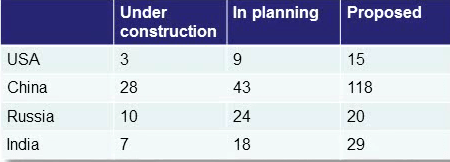
Whereas there have been virtually no new nuclear reactors built in the US or Canada in the last 30 years, in fact four nuclear power stations were closed down in the first half of 2013 as of July 2013, the US has three in construction and another nine being planned. China by comparison has 28 under construction 43 more in the planning stage and 118 proposed, for Russia the same figures are 10 under construction 24 in planning and 20 proposed for India 7, 18 and 29. So these are large numbers of reactors and they are going to need uranium to power them so where are they going to get it all from.
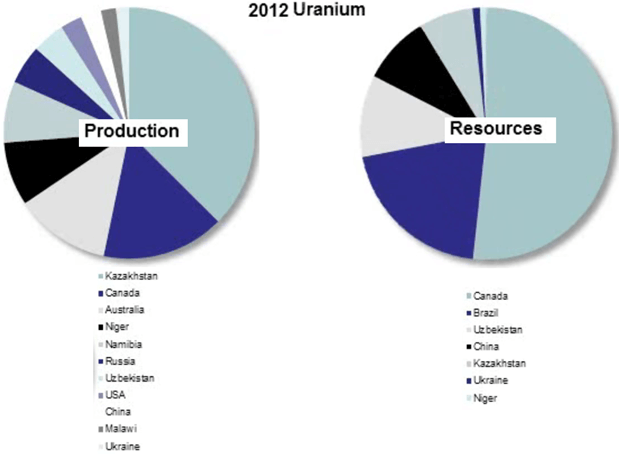
Let’s look first at where the current suppliers are coming from. The top producers globally in order of the size of production are Kazakhstan, by far and away the biggest producer, Canada, Australia, Niger, Namibia, Russia, Uzbekistan, USA, China, Malawi and Ukraine. Looking ahead the list of defined world uranium resources is somewhat different. Canada stands head and shoulders above the rest of the world thanks largely to the Athabasca basin; it’s followed by Brazil, Uzbekistan, China, Kazakhstan, Ukraine and Niger. Interestingly the Uranium that was used in the world’s first two atomic bombs was mined in the Congo DRC a country which doesn’t even feature on the current list of either producers or holders of resources. Uranium metal is the most unimpressive looking material, it’s a dull silver gray material it’s heavy with specific gravity of 18.7 almost the same as gold but unlike gold uranium metal never occurs in the elemental form in nature it’s always combined with other elements and these are some of the more common uranium minerals; Uraninite, including pitchblende is one of the most common ore minerals it has a black lustrous color and is an oxide of uranium, Brannenite another more complex oxide is also black although it may have a slightly yellowish tinge sometimes, Carnotite it’s complex but more common in uranium or mineral and is usually bright yellow or orange and is most common in secondary uranium deposits. Those where the uranium that are deposited by groundwater. Uranophane are hydrated calcium uranium silicate it’s yellow green in color but it will fluorescent bright green if you put it under a UV blacklight and finally Autunite a calcium uranium phosphate is also yellowish green in color.

Now let’s move on to the various deposit types that uranium occurs in. There are at least 14 different deposit types as you will probably have noticed some geologists are splitters but only six of these are really economically significant in global terms. These can be broadly grouped into two; primary deposits where the uranium is introduced with the original magma and secondary deposits where the uranium is dissolved by groundwater and then re-deposited on solution.
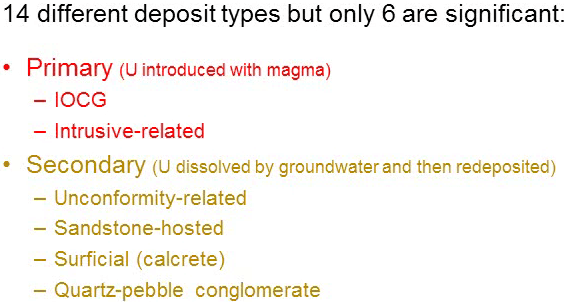
Most of the primary uranium deposits are associated with either IOCG – Iron oxide, copper, gold deposits or with mesothermal veins and pegmatite in other words deposited directly from magmas or by hydrothermal fluids derived from felsic rocks at intermediate depths. The first of these primary deposit types are IOCG’s virtually the only economic uranium deposit of this kind and type is BHP giant Olympic Dam deposit in South Australia. Although it is the only significant IOCG uranium mine, it produces almost 4000 tons of U3O8 per annum making it the second-largest producer in the world after MacArthur River which provides about 6% of global uranium production.
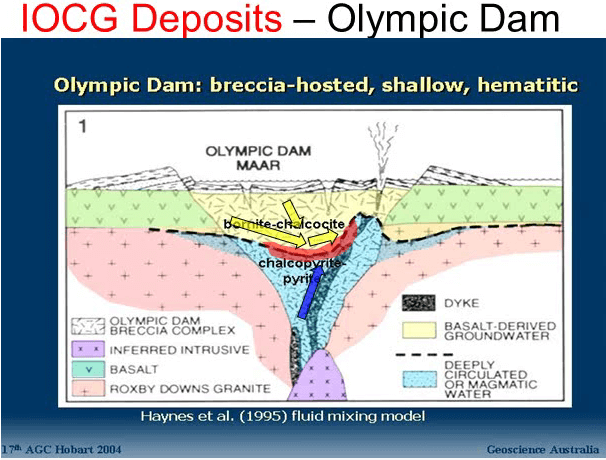
Olympic Dam has an incredibly low uranium grade of just 0.034% U3O8 and the only reason it can produce at this grade is that it’s primarily a copper producer and the uranium is just a fortunate by product. The resources of the Olympic Dam are a stunning 9.5 billion tons, there were plans to double the annual production but environmental and antinuclear protest have put these plans on the back burner for the time being. It is pretty old but I don’t think the model has changed much since 1995 when it was published. The genetic model calls for a mixing of cool, shallow saline oxidizing groundwater from within the basaltic volcanics, which are yellow in the section with hot deep more reduced magmatic water; blue in the section, the uranium is postulated to have been brought in with a shallow saline water and precipitated in the mixing zone due to reduction, as you will see this precipitation of the uranium from unoxidized fluid as a result of the reduction is a common theme in uranium deposits.
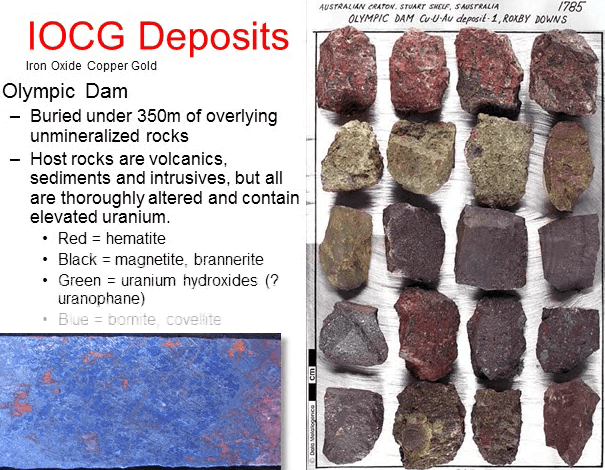
The top of the Olympic Dam mineralization is at a depth of 350 m below surface buried under transported cover and baring post mineral sediments. The mine is being operated as an underground mine since its inception. The new expansional core for the development of a super pit.
The mineralized rocks are quite impressive being full of red hematite, various green uranium minerals, blue bornite and black magnetite-pitchblende and brannenite.
So if the Olympic Dam is hidden under 350 m of overburden and post mineral sediments; how do the explorations discover it and the other IOCG’s that are similarly buried? Geochemistry won’t work unless the deposit is at or close to the surface instead geophysics plays a dominant role, because IOCG deposits have several features that geophysical techniques can detect. If the deposit outcrops radio-metrics may work, however this is not the case in the Olympic Dam area but magnetics can detect the abundant magnetite that is often associated with IOCG’s.

Gravity may be able to differentiate between heavy magnetite, hematite and sulfides of the ore and the lowered density and mineralized rocks, you can see how well this worked at Olympic Dam which is found due to both its gravity and magnetic geophysical signatures although the two are not fully co-incident and only overlap over a small portion of the ore body.
Gravity outlines the permissive area but pinpointing the actual mineralization is much more difficult and finally EM or Electro Magnetics may be able to detect an IOCG’s massive sulfides, however at the end of the day as usual drilling will be required to validate the geophysical anomaly.
Intrusive related, primary uranium deposits: Although granites generally contain higher background levels of uranium than mafic or ultramafic rocks primary deposits can be associated with intrusives of all sorts of different compositions. The Phalaborwa deposits in South Africa for example are hosted in carbonatites and ultramafic.

Intrusive related uranium deposits provide one of the clearest examples of magmatic concentration of metals with the uranium being concentrated in the last remnants of the magma crystallized, however the grades are still some of the lowest in the uranium deposits for example Rossing in Namibia namib dessert which you can see in this satellite image has a grade of just 0.035%, just 70 times that of the average crustal abundance.
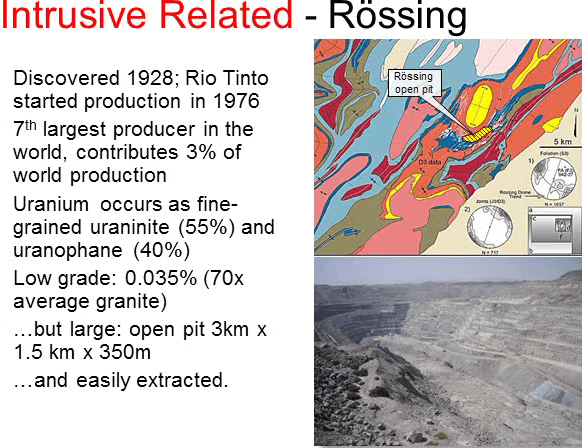
Rossing was discovered way back in 1928 but with little use for uranium until after the second world war and the development of nuclear power it only finally got into production in 1976 , its share of the world production is steadily shrinking and is now only 3% compared to 7% five years ago. Uranium occurs as fine-grained Uraninite and Uranophane in alaskite; a granite with virtually no mafic minerals. Whereas Olympic Dam produces uranium only as a byproduct, rossing is a pure uranium producer. In spite of its very low grade it is economic because of its size and importantly the fact that the uranium minerals occur between the feldspar grains and it takes little grinding to achieve higher recoveries. There are several other deposits nearby that are in advanced stages of exploration and evaluation.
As for the IOCG’s explorations for intrusive related uranium deposits, relies very heavily on geo-physics. An earlier reference to radio-metrics as an exploration tool when discussing the IOCG’s as the Olympic Dam is deeply buried but let’s course a little bit about it here as it is a pivotal exploration tool for shallow or out cropping deposits. Uranium decays to produce Alpha particle radiation and this can be detected with a scintillometer or a spectrometer if the radiation source is within say 30 cm or 1 ft. of the surface. Below this the overlying material masks the radiation. Most radiometric surveys have flown using either a helicopter or fixed wing aircraft. An airborne spectrometer is more sophisticated than a scintillometer and it can differentiate between radiation from uranium, thorium and potassium because they can’t do those the reading from scintillometer need to take with a pinch of salt and much of this radiation could be simply from valueless potassium or thorium.
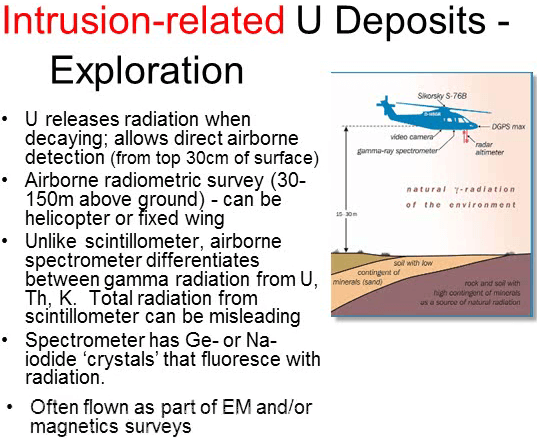
Spectrometers rely on germanium or sodium iodide crystals, their fluorescence and radiation. Spectrometers sensitivity depends on the size of that crystal and it can vary from 15 to 30 liters in volume. The size obviously impacts the weight, as they weigh up to 100 kg the weight of a very large man and hence impacts on the cost of flying a survey. Airborne radiometric surveys are usually combined with EM or magnetic surveys to make the most of the aircrafts availability. Once the radiometric data has been collected by the airborne survey it’s processed and plotted to provide maps of uranium, thorium and potassium radiation intensity.

Here you can see one of those maps on the survey of Western Australia, you can see the uranium anomaly of the Muggaburna uranium mineralization lighting up in red. Once radiation is detected from the airborne survey exploration moves on to the ground for geological mapping, surface sampling and of course drilling. Drilling can be core or RC. It’s possible to get a very quick estimate of the uranium content by using down whole spectrometer probes like this but this only gives counts per second and you need to follow this up with chemical assay of the core or chips in the lab to get results that can be used in estimating results.
Secondary uranium deposits are classified as secondary because they result from groundwater leaching uranium from a primary source rock; the uranium is then transported in solution and re-deposited often resulting in a major grade increase.

We are now moving from high up into this diagram to the very shallow areas where groundwater circulation plays an increasing important part in the formation of ore deposits. Secondary uranium deposits are all founded on one underlying principle; namely that uranium is soluble in oxidized water but insoluble in reduced water. So if we have a rock containing a low grade uranium and oxidized groundwater flows through it, the uranium will be dissolved.
If the uranium baring groundwater then encounters any reductants the groundwater will be reduced and the uranium will precipitate straight out of solution. Most common reductants re carbon in the form of graphite or buried organic material or sulfide such as pyrite, so the secret to exploring for secondary uranium deposits is to consider a potential oxidized primary source, to determine where the groundwater flowing through the source is likely to encountered these reductants.
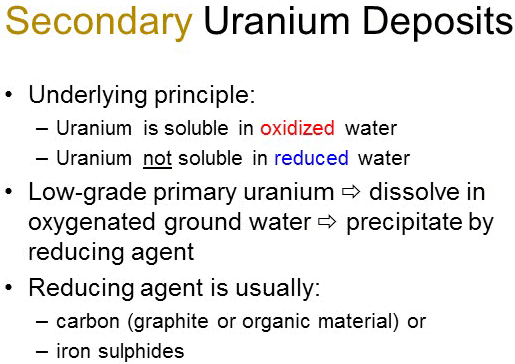
An unconformity related deposits are some of the most important uranium deposits economically as well and we will start with these and I’ll spend quite a bit of time on them giving their importance to the uranium mining industry.
What exactly is an unconformity related deposits? An unconformity is the erosion surface providing the older and younger rocks usually of very different ages, you can see a tip of unconformity in the photo where the older rocks are underneath but folded and eroded before the younger red-brown sediments were deposited on top and the yellow line marks the unconformity. Sometimes the upper and lower rocks have very different degrees of oxidation which makes the unconformity a redox boundary.
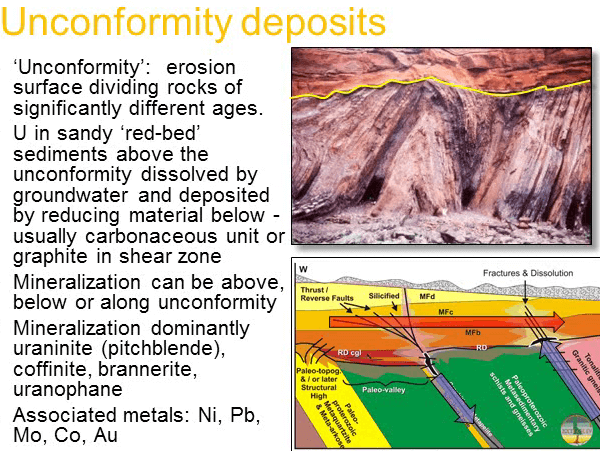
Usually in these cases the uranium is dissolved in relatively oxidized groundwater in the upper unit and then drops out a solution when this water mixes with reduced water infractures in the lower unit depending on whether the groundwater is travelling upwards or downwards so-called egress or ingress situations the uranium will drop out in the upper or lower unit but either way it is generally within a couple hundred meters of the unconformity. The specific uranium minerals that is deposited and the associated metals generally depend upon the composition of the reduced fluid.
Unconformity related deposits are generally far and away the highest grade uranium deposits and provided the biggest contribution to the Western world’s uranium production. The 33% coming from this group of deposits. Most production comes from Canada’s Proterozoic basins. The Crown Jewel on the map of North America, Saskatchewan Athabasca basin is the jewel and the crown, many world deposit class of uranium deposits are located here including Cameco Key Lake, Denison’s Wheeler River, Cameco MacArthur River and Cigar Lake and Rio Roughrider deposit and Fission and Alpha Patterson Lake South.
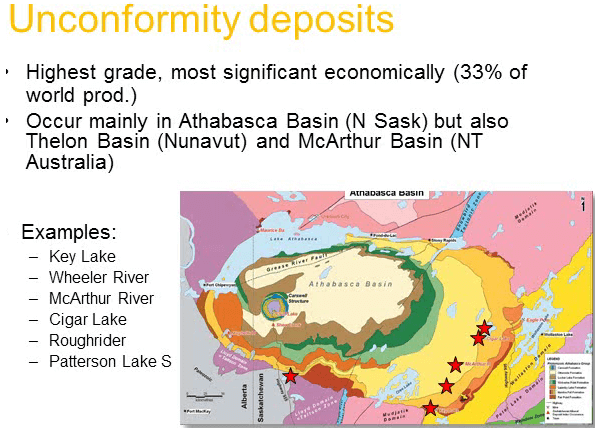
This last deposit appears to be outside the Athabasca basin but in fact the basin used to extend South over Patterson Lake before glacial erosion removed it leaving just the roots of the system in the lower stratigraphic unit.
First let’s look at Cigar Lake mine as an example of a typical unconformity related deposit. Although its grade is high even for unconformity related deposits and then we’ll take a look at two pre-development deposits. Cigar Lake is jointly owned by Cameco and Areva and is under development. At Cigar Lake the mineralization is above, on and below the unconformity, suggesting that the deposits formed over long period and that the groundwater moved both up and down the basin structure during that time. The deposit has a well-developed clay alteration halo the orange unit in the cross-section; beyond that is an even larger bleached zone blue in the section. The mineralization buried beneath about 450 m of largely un-mineralized flat lying upper Proterozoic sand stones.

The basement consist is formed on lower Proterozoic sediments. In broad terms the mineralization looks like an almost 2 km long flattened snake winding along the unconformity and following a basement structure. As I mentioned Cigar Lake has incredibly high-grade and averages 20% U3O8 this mean that the ore is worth fifteen thousand dollars per ton at today’s price of $35 a pound. Some sections of the ore deposit exceed a staggering 50% U3O8. The reserve not resource at Cigar Lake is 537,000 tons at 18.3% U3O8 for 216 million pounds of U3O8, total production is planned to be 223 million pounds. Production is scheduled to begin in late 2013 and mine life is estimated to be 15 years. A recent deal with Areva and the joint venture partners and owners of the McLane Lake mill has lowered the forecast production cost to about $18.60 per pound.
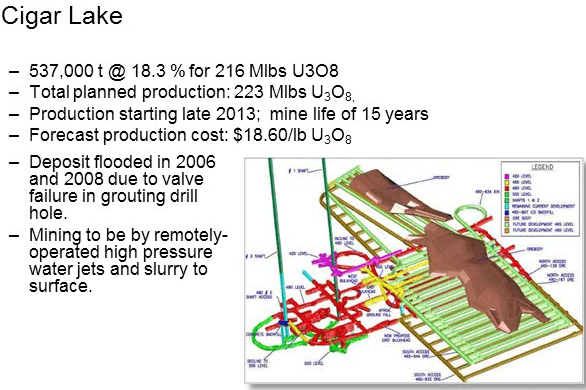
deposit has had a torrid development history with major setbacks caused by flooding in 2006 and the difficulty of designing a safe mine with such a high grade of ore. A new second shaft was completed in early 2012 which have allowed development to continue. To avoid human contact with the ore as much as possible mining will be remotely operated for high pressure water jets. The pulverized ore will then be carry to surface in pipes and de-watered before being trapped in McLane Lake mill. The recovered water will be recycled.
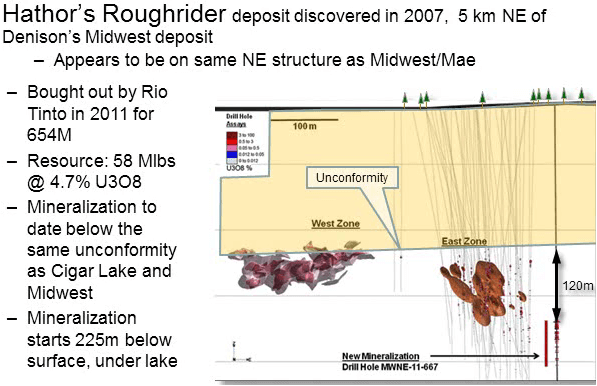
The Roughrider deposit was discovered by Hathor in 2007, 5 km to the Northeast of Denison’s Midwest deposit. Hathor was brought out by Rio in 2011 for $654 million dollars; total resource at that time of the sale to Rio was 58 million pounds at 4.7% U3O8. Roughrider consists of at least three pods of mineralization all at or below the regional unconformity. This Hathor image shows a vertical section through the three deposits, at that stage the third pod had only one drill-hole intercept. The first point to note is that the individual pods in this type of deposit are tiny the biggest footprint is only 160 x 60m. The second point is that the shallowest of the three pods, of the original discovery is at the unconformity and 225m below the surface but the top of the third and deepest pod is 120m below the unconformity and it extends to at least 400m below surface. The fact that the third pod was so far below the unconformity is unusual but it is not unheard of as another recent discovery shows.
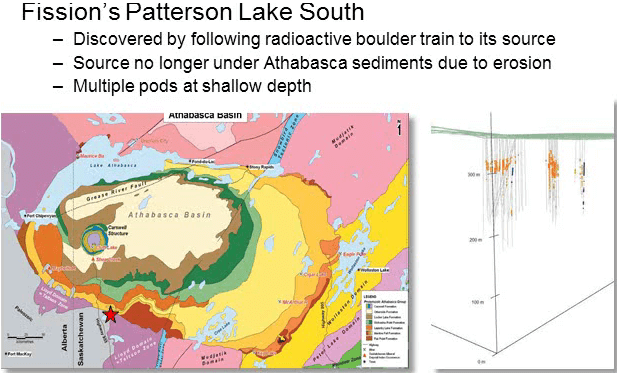
Fission and Alpha minerals discover new mineralization by following a radioactive boulder trend left by glaciers to what they believe to be the bed rock source, as I mentioned earlier the Patterson Lake mineralization lying several kilometers outside the current limits of the Athabasca basin however the Athabasca sediments once covered this are before they were removed during at least two erosional periods but some of you uranium mineralization which predates the erosion still remains. It’s hard to estimate how deep below the original unconformity the ore formed but it was probably at least a couple of hundred meters, however the erosion means that the multiple pods in mineralization are now covered by just a thin skin of glacial deposits and so portions of them are probably going to be open pittable. No resource has been released by Fission yet for the average grade of the drill intercepts as I write this, is 3.6% U3O8, not quite as high as the Roughrider but the mineralization is much shallower than that Roughrider.
Let’s review a little bit about exploration for unconformity related uranium deposits. As I mentioned they are usually blind that is they don’t outcrop at surface. Not only that but the Athabasca basin is in the North of Saskatchewan with its tough winters and transported glacial cover, which makes them challenging exploration target. Explorationists need a sound systematic exploration strategy if they are to succeed.

Let’s look at the steps starting with first order targeting; firstly almost all of these were formed during the Proterozoic, the red blobs on the map of North America. So we need to focus on these rocks particularly where there is an oxidized red-bed sediment overlying an older more reduced sequence. Then we need to add late Proterozoic granites and pegmatite’s to act as the primary sources of uranium in the oxidized red-bed sediments.
Finally we need crustal scale faults in the basement to provide a focus source of reduced fluids to cause the uranium to drop out a solution. These requirements drastically reduce the number of potential terrains where we could begin looking for these deposits. Once we have established the regional scale targets we can step down into the second order that’s targeting because the deposits are usually overlaid by transported sediments that radiometrics cannot penetrate, radiometric surveys are of little use. Therefore we have to rely on indirect methods that recognize features associated with fluid plumbing and potential reduction traps. These include various EM techniques and magnetics which can identify structures and graphitic units which may provide sources of reduced fluids. Seismic which detects the steps in unconformity that may represent fault displacements and using geochemistry to detect radiation leakage through the overlying sediments.

This image shows uranium anomalies in lake sediments in Québec. Lake sediment samples are collected by dropping a hollow sphere into the lake from a boat or helicopter. Some success is being claimed on sampling lake water for radon a daughter product of uranium decay. Other exploration methods include identifying clay alteration styles that form a halo around the deposit. Once these indirect methods have been applied, it’s time for direct testing in the form of drilling. When a hole is being drilled, down hole spectrometry will give a quick indication of the grade mineralization before the assays are available.

Now for groups of secondary uranium deposits starting with the Sandstone hosted style uranium deposits. The reduction of oxidized uranium baring meteoric water is the key here. In Sandstone hosted deposits as the name implies the uranium is deposited in sandy sediments usually incubated with shale or mudstones by coming into contact with plant debris or sulfides that act as reductants, as a result fossilized wood is often somewhat radioactive. Approximately 18% of the world’s uranium resources offered the Sandstone hosted style, so it is a significant one. The deposits are usually low to medium grade, higher than most primary deposit but not as high as an unconformity related deposits.
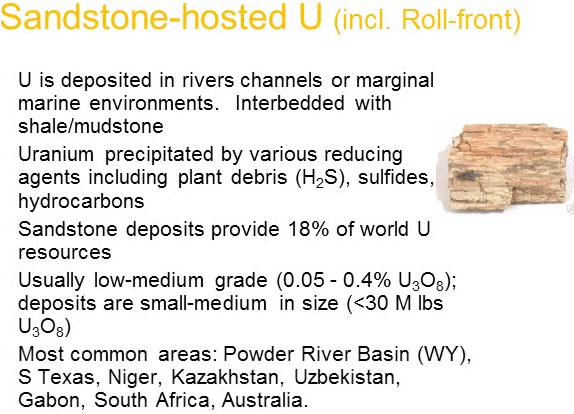
The best known areas for these deposits are the Powder River basin in Wyoming, South Texas, Niger Kazakhstan, Uzbekistan Gabon, South Africa and Australia in other words they are pretty widely spread.
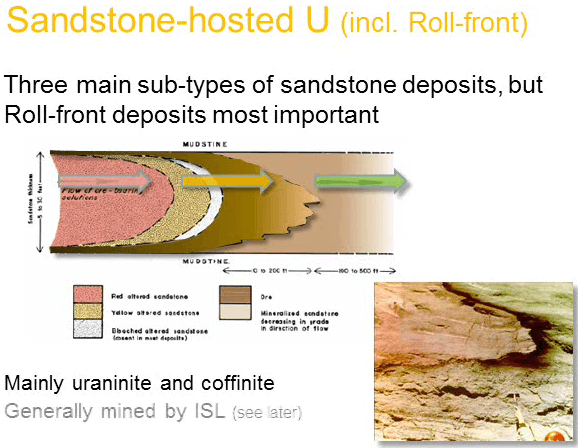
Roll-front deposits are particularly subset of the sandstone hosted deposits and indeed they are the most economically important of the sandstone hosted deposit types. Here oxidized groundwater flows along a reduced sandstone beds dissolving uranium already in the sandstone and then re-depositing it as the water steadily reduced by organic matter or sulfides in the sandstone. The uranium forms irregular or crescent shaped blobs where the oxidized sandstones become reduced as you can see in this photo. Uraninite and coffinite are the usual minerals deposited, so the mineralization is usually dark, dark brown or black. In most cases roll-front deposits are mined using In Situ Leach or ISL technique.
The second to the last group of the secondary deposits are the Sufficial deposits. These are formed at the surface due to evaporation of uranium baring groundwater So they are usually hosted in recent sediments or soil profiles because of the evaporating groundwater contains salts in addition to uranium the host rocks are usually cemented by calcite, gypsum, dolomites or ion oxides. Calcrete or Caliche is the most common host.
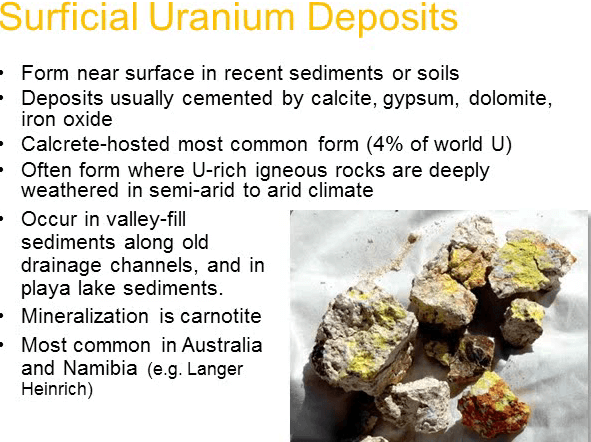
original source of the uranium is usually deeply weathered granites and the groundwater that drains these granites usually reaches the surface in seasonal river channels and playa lakes so these are the favored deposit locations. The most common uranium mineral in sufficial deposits is sulfur yellow carnatite. This type of deposit obviously needs low rainfall but higher evaporation to form and Australia and Namibia host several deposits of this kind.
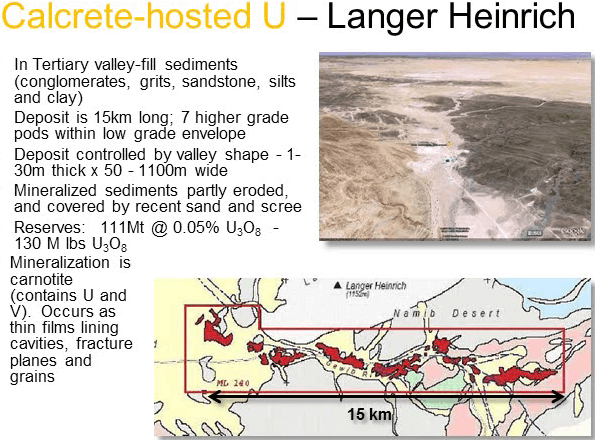
Langer Heinrich is a well-known example of calcrete hosted sufficial deposit. It’s hosted by young sediments in a Sandy River Valley in the deserts that drains an area of uranium rich granites. You can see the Sandy Valley running up the center of this area of the operation. The mineralization forms a series of seven flat pods spread out over a 15 km section of the channel, individual pods vary from just 1 m thick to up to 30 m thick and are over 50 m to over a kilometer in width compare this to the footprint that we were looking at earlier of the unconformity related deposits which are tiny by comparison. Langer Heinrich reserves contain 130 million pounds of U308 at a grade of .05% U308, The carnatite that makes up the mineralization occurs at as thin forms aligning cavities, fracture plains an individual grains so it is easily leached.
And so on to the last of the deposit types the Quartz-Pebble Conglomerate. These make up approximately 13% of the world’s uranium resource but only a few percent of the global production. They can be either primary uranium producers or byproduct producers and the average grade depends upon which they are, obviously the byproduct producers can work at a much lower cutoff and grade than the primary producers but either way the grades are generally low two of the best-known examples are Elliot Lake in Ontario which is a primary producer and the Withwatersrand mines which produce uranium as a minor byproduct to gold production. The Quartz-Pebble Conglomerate deposits can be very large varying between 12 and 375 million pounds U3O8 and most of the mineralization is in the form of black uraninite which is unusual for secondary deposits.
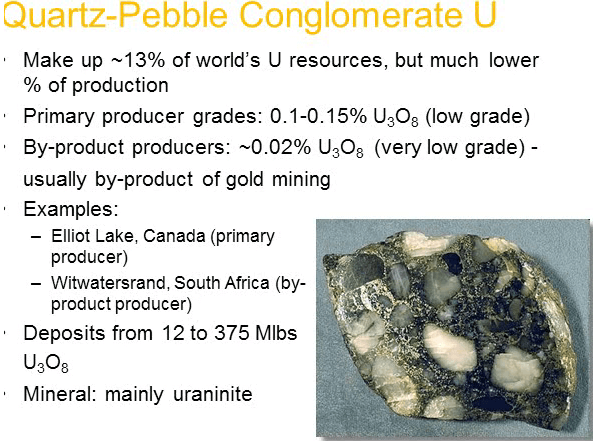
Mining and processing of uranium ore: The three mining methods; open pitting, underground mining and In Situ Leach or ISL. The advantage of open pitting over underground mining quite apart from the economic advantage is that the hazards associated with radon gas are significantly reduced due to better ventilation in a pit however the environmental dust concern is less easily addressed. Most of the high-grade unconformity related deposits are too deep for pitting and are underground operations; great care must go into the safety aspects of running a mine.

The health dangers are minimized by using remote mining techniques, controlled from outside the ore body or even from surface. This involves hydraulic mining using high-pressure water jets and pumping this hurried ore to surface or deliberately diluting the ore with (Inaudible 39:05) to drop the level of radioactivity of the handled material, minimizing dust and maximizing ventilation and using radiation badges to monitor exposure and ensure that internationally established safety levels of exposure are not exceeded.
The third method of mining is the In Situ Leach or ISL. It’s also variably referred to as in situ mining (ISM) In Situ recovering (ISR) or In Situ extraction (ISE) but they are all the same process. It’s used in cases where there is a poor sandstone host sandwiched between two impermeable beds as is often the case with roll-front deposits, no traditional mining is used. The process relies entirely on bore holes pumping a solution that will dissolve the uranium in place down one set of bore holes and then pumping the uranium pregnant solution back up a different set of bore holes to the surface it relies on the same redox principle that we have seen before and also on changing the ph.

The amount of solution pumped into the ground is always slightly less than the amount pumped out so that the solution does not migrate out of the leached area. The solution may be slightly acid or alkaline depending upon the nature of the deposit but the solutions are generally pretty benign. Carnotite is insoluble but most of the other yellow uranium oxides such as uranophane are leachable.
How is the uranium extracted from the ore:
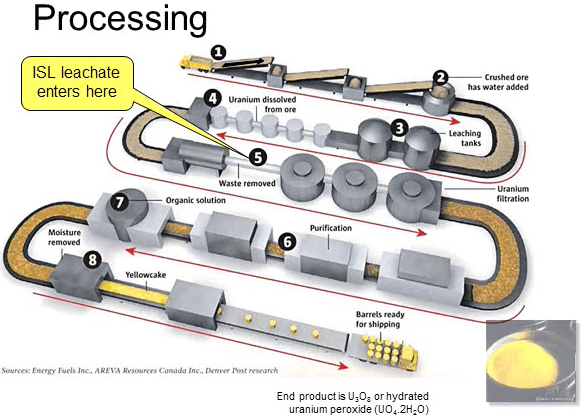
Ore from pit or underground mining is crushed and slurried to the mill a weak acid or alkaline solution in hydrogen peroxide to oxidize solution is added so that the uranium dissolves. The uranium is then filtered to remove the now spent solids leaving just the pregnant leachate. If the mineralization has already been leached using ISL the leachate enters the circuit at this point. After purification ammonium sulfate is added to the solution which causes the U308 to precipitate. The precipitate is then filtered out, then dried and voilà red yellow cake.
Primary deposits include IOCG’s and intrusive related deposits. Secondary deposits include unconformity related deposits, Sandstones hosted and Roll-front deposits, Sufficial deposits including calcrete and Quartz-Pebble Conglomerate deposits. Grade is king; unconformity related deposits such as the Athabasca deposits are the Cadillacs of uranium deposits but they have tiny footprints and seldom out crop making them challenging exploration targets. Exploration tools uses to find uranium deposits include Gamma-Ray spectrometers to detect the uranium directly and various electromagnetic methods such as EM, CSAMT and mag and seismic for blind deposits. The key in the secondary deposits is to find the redox boundaries where uranium traveling in oxidizes groundwater will be reduced and precipitate from solution. The big boys of uranium are Canada, Australia and Kazakhstan. Mining can be from open pit, underground or In Situ Leach leaching and uranium mining is no more dangerous than other forms of mining but the emotions surrounding the radiation clouds the issue. Public perception is slowly improving due to the raise as a perceived green energy source but events such as the Fukushima leak and after the tsunami damage the setback the uranium industry by 5 to 10 years. So that’s the end of this introduction to uranium deposits.
